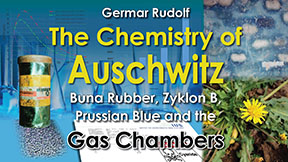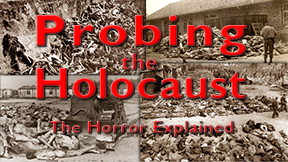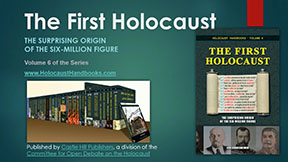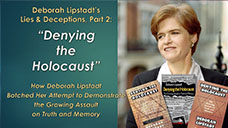This is the work that started everything: my fame and my infamy, my rise to a hero and my fall to the devil incarnate. Starting in 1991, this purely technical and scientific expert report was prepared on the requested of a German defense lawyer for the defense of his client who had been indicted for “Holocaust denial,” which in Germany is a crime punishable with up to five years imprisonment. Since introducing evidence supporting revisionist claims is illegal in Germany, my original German expert report of 1993 has never been accepted by any court of law. They indicted and eventually jailed me for my research results instead, because they contradict numerous witnesses, among them some allegedly infallible, sacrosanct “Holocaust survivors.”And here is how the 2017 edition is being advertised at www.HolocaustHandbooks.com:
Holocaust Handbooks, Volume 2:
Germar Rudolf: The Chemistry of Auschwitz—The Technology and Toxicology of Zyklon B and the Gas Chambers – A Crime-Scene Investigation
4th, revised and expanded edition
Auschwitz was a center of chemistry. The German chemical industry built gigantic factories for rubber, fuel, lubricants and methanol there, and the SS experimented with natural sources of rubber. But that’s not what people associate with the name “Auschwitz.” They think of gas chambers and Zyklon B, which are two entirely chemical things as well.
The gas chambers of Auschwitz have been called the epicenter of human suffering. More human beings are said to have died a violent death there than on any other place on earth in the history of mankind.
The biggest crime scene of history, in terms of its death toll, not only demands the utmost respect for its victims, but should also attract the most-intensive attention of forensic researchers to find out what exactly happened, and how. Or so one might think.
Forensic research on Auschwitz, however, has always been controversial. Investigating the gas chamber mass murder is considered a blasphemous act, a way of disturbing the peace of the dead.
While respecting the victims, whether of foul play or of circumstance, this study nonetheless tries to conduct Auschwitz research on the basis of the forensic sciences, where material traces of the crime and their interpretation reign supreme. Although it is generally agreed that no autopsy of any victim has ever been performed, most of the claimed crime scenes – the chemical slaughterhouses called gas chambers – are still accessible to forensic examination to a greater or lesser degree. So, how did these gas chambers of Auschwitz look like? How did they operate? What were they used for? In addition, the infamous Zyklon B can also be examined. What exactly hides behind this ominous name? How does it kill? And what effect has it on masonry? Does it leave traces that can be found still today?
These and many other questions are thoroughly examined in this study. The horror of Auschwitz is meticulously dissected, and thus, for the first time, it really becomes comprehensible.
Full color edition with 129 color illustrations!
Learn more about this book, and how to purchase it, here.
| Item Properties | |
|---|---|
| Published by: | Uckfield: Castle Hill Publishers |
| ISBN: | 978-1-59148-238-3 |
| Pages: | 456 |
| Edition No.: | 4, slightly revised and expanded |
| Release Date: | 4/2020 |
| Illustrations: | 129 color; 102 b+w |
| Features: | Index, Bibliography |







